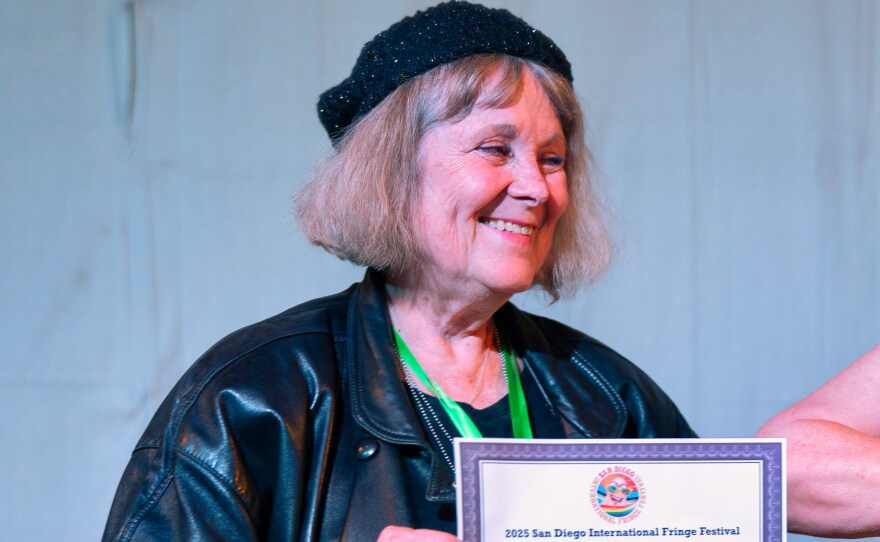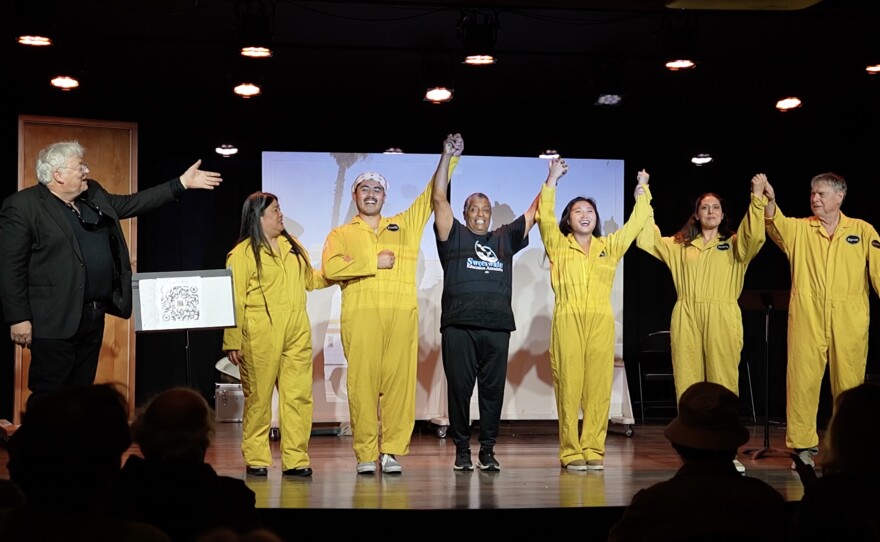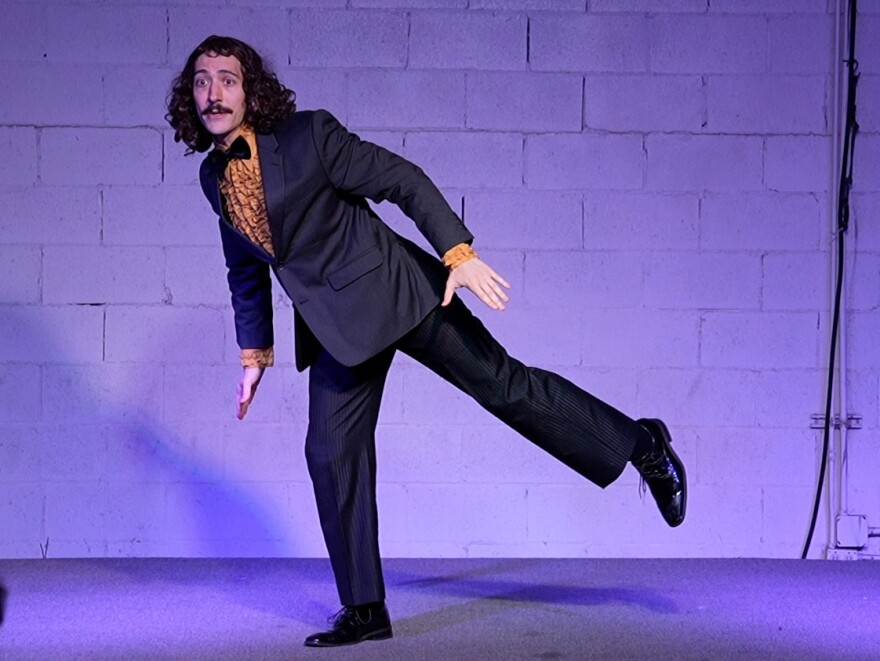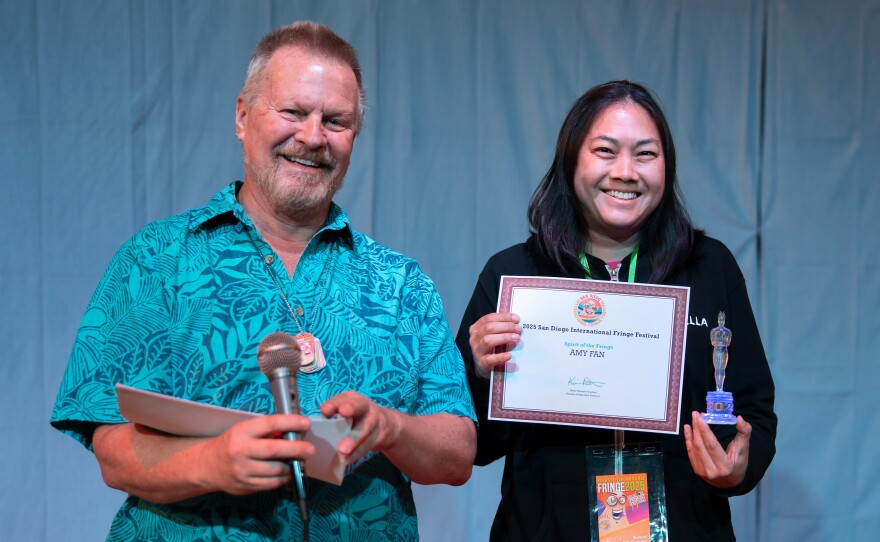The 13th San Diego International Fringe Festival closed on Sunday with an awards show honoring artists from more than 40 shows.
Beth's awards
I saw 39 of the 48 shows that ran, and thanks to my friend Amy Fan (who won the Spirit of the Fringe Award for volunteering her time to film shows), I was also able to watch a half-dozen more shows.
Picking the best of the Fringe this year was tough. The shows were wildly diverse, and many of the stories were so personal that even when shows were flawed, they were often moving and compelling. Picking the best is a very personal thing, and at a Fringe festival it can also depend on which performance you saw (things can go awry on the opening night of a show, where the tech crew might have only had one hour to learn all the cues). So after much agonizing debate with myself, here are my picks for what impressed me the most, or entertained me, or just left me with indelible memories.
Top 10 Fringe Shows of 2025
"Smile: The Story of Charlie Chaplin" — Marcel Cole weaves wonderful clown and mime work into a story of Charlie Chaplin's life, movies, political hardships he faced and the ideals he presented in his art. Great on multiple levels.
"Just to Be Close to You" — Hands down the most unexpectedly funny show of the festival, with Cameron Poter as a lounge singer with only one song to perform. Somehow, he charms the audience into repeatedly begging for one encore after encore. Hilariously uncomfortable and awkward.
"Queen of Fishtown" — Katierose Donohue Enriquez was so convincing as a working class Philly woman that people kept confusing her with her character, including one of our newspapers. She had a sharply written, well-observed piece and played it to perfection, making us feel like we were on the stoop drinking a beer with her character, Kathleen.
"Faking It" — Olivia Raine Atwood had a crazy real-life story about being a fake COVID-19 patient to test hospital protocols in rapid-fire, hilarious fashion, with a well-charted narrative that brought the story to a surprisingly circular conclusion.
"Mae West Cleans Up Her Act" — Wendi Wynazz had some kinks in her production, but smartly scripted tech problems into her story of Mae West making a comeback show. Wynazz brings West to vibrant, vivid life and reminds us of what a bold, brash, talented woman West was. Wynazz also displays great physical comedy.
"Title Pending" — Excellent and often funny writing, plus a forceful performance about escaping the boxes we sometimes find ourselves in — or put ourselves in.
"Matt Harvey — Wage Against the Machine" — Fine and funny comic writing and storytelling with great empathy for working-class folks with dodgy jobs and hypocritical governments. He accurately described his comedy as crossing international borders to unite people in shared trauma.
"husk/vessel" — A visually gorgeous and compelling experimental dance piece.
"Rince Panic" — Michael Prine debuted a version of this last year but added some rap poetry that just took the show to new levels.
"Futakuchi Onna" — Kristin Joy Moran finds both humor and horror in her exploration of personal demons and yōkai monsters. She also elicits compassion.
Honorable mentions
"Así suena México" — Absolutely stunning choral music featuring popular songs from different parts of Mexico. The voices were just spectacular.
"Nighttime Julianne" — An impressive first Fringe show from Lani Gobaleza. She crafts a sincere and heartfelt story about loss and grief.
"Fre3sty13" — Eve displays an impressive, gorgeous voice and fierce talent.
"Birthday" — Michael-David Ker may lack bold confidence on stage, but he turns that to his advantage with a conversational style of storytelling that proves compelling and funny. Ultimately, it is a story about surviving grief and loss without losing your sense of humor.
"The Fetus Show" — This show was the Fringiest show of the festival. Uneven but fueled by some inspired lunacy and creativity.
"I Killed Iphigenia" — Although this show could use some fine-tuning, it bursts at the seams with youthful, passionate energy; deeply personal storytelling; and clever use the myth of Iphigenia to explore trans themes.
"I Blame Florida" — Kelly Spillman has stage 4 cancer and somehow manages to find humor in that and make us laugh. She explains that she came to stand-up comedy after attempting other careers but she has taken to it with great gusto and well-tuned writing.

This year's festival featured more solo female performers than I can ever recall, as well as three shows focused on trans identity and transitioning. It felt like the unjuried and uncensored platform that Fringe offers was eagerly embraced by artists who were not feeling heard elsewhere.
Trans visibility
Mawce Dunn turned her UCSD thesis project into the Fringe show, "I Killed Iphigenia: A Trans Drag Perspective," which explored being trans masculine through the myth of Iphigenia.
Dunn said, "Fringe has given me a space to do radical, weird art and be inspired by other out-of-the-box artists like me. I think a huge benefit of Fringe is the exchange of ideas and inspiration between artists. This is not the end of 'I Killed Iphigenia.' This piece will continue to grow and change with us. We are planning to stage it at Hollywood Fringe Festival 2026. This is a story for queer and trans people, and we want to reach as many as possible."
Alisha Richard also had a trans-themed show with "Alisha's Light: The Parking Lot Poems."
Richard attended Fringe last year and read one of her poems for a trio of Fringe artists in the parking lot of the New Destiny venue. They encouraged her to bring her poems to Fringe. She crafted a show and then was chosen to participate in Diversionary Theater’s Stonewall Salon, a showcase for LGBTQ storytellers over the age of 50 with the goal of delivering theatrical stories.
"The Diversionary crew and the other storytellers helped me grow so much in such a short time," Richard said. "Then my experience with the San Diego International Fringe Festival has been life-changing. It helped me realize that beyond being a poet and storyteller, I could create something that could be labeled theater. Fringe is the ultimate workshop opportunity. You can take an idea and play with it over the course of a five-show run. You can focus on the art without having to book your own venue, set up ticket sales on a platform, and do all of the promotion on your own to get an audience. This was my first Fringe. However, the other artists said the camaraderie in San Diego is next-level. I loved attending performances, chatting and hanging out with my fellow artists. I have a feeling that some of us in-town folks are going to start brainstorming how we can make Fringe 2026 bigger and better."
An uncurated, unjuried platform for artists
Sarah LeClair of Riot Productions came to Fringe in part out of frustration with the lack of strong female roles for actresses.
"My acting coach at the time, Cris O'Bryon, said if the work isn't there, then you should create your own," LeClair recalled.
And LeClair did. She wrote "Audition Sides." But she could not get a space to perform it.
"When I discovered that Fringe was uncurated, I understood immediately — this was for the people who had spent the time knocking on doors and had been denied," Le Clair said. "So bringing my piece to Fringe last year — where it won Outstanding World Premiere — changed everything. I suddenly realized that I didn't have to ask permission from f---ing anyone. I could just write, and perform, and Fringe gives us the space whether or not it works with the festival or works with the other pieces or matches what else is going on around us. No one judges it, they just come and listen."
This year, LeClair saw a theme running through a lot of shows.
"I see a lot of people coming to Fringe to speak on their experiences of grief and loss," LeClair noted. "In the solo shows especially, processing their trauma in front of an audience, and Fringe facilitates that in a way that feels safe — you can talk a little about what you're going to say on social media and invite people, and they can come to hear your story if they feel ready to hear it, without you needing to tell all of this to them in your living room. Primarily, what I see of local people at Fringe is marginalized performers who have a platform in the festival. I know for myself, as a local producer with Riot Productions, I use the funds from Fringe to support the new work that we produce all year round. So I think we're all trying to change what the stories are that are being told within our city, and asking our local audiences to support stories they haven't heard before, and proving as well that people will show up and pay to see experimental work, especially now."
Local award winners
Riot Productions' "Death and Murder and Poison and Scene" won Outstanding Ensemble Performance.
"This kind of award is a laurel that we can tout when we apply for grants, and it benefits not only the single production but everything we do in a year, as we work to amplify women at the intersection of the LGBTQIA+ and BIPOC communities. And we are so, so grateful for that gift," LeClair added.

Another local artist who took home an award was Lani Gobaleza. Her solo show "Nighttime Julianne" won Critics' Pick.
"Even though none of us do the work we do for awards, being an artist can at times feel lonely and draining," Gobaleza said. "It means a lot to be acknowledged at any level, be it a quick comment after a show, a pep talk between artists, or an award."
As with Richard, Gobaleza was encouraged to participate in Fringe through other artists and through a playwriting series at Diversionary Theatre.
"Back then, the piece was a playful perspective on queer sexuality," Gobaleza said. "I tabled it for months after facing a few great losses in the family, and those personal experiences led me to shift the themes of the play."
After a series of rewrites, she had "Nighttime Julianne" ready for Fringe.
"Fringe has been by far the most accessible way for local artists to share their work, get immediate feedback and learn from global artists," Gobaleza said. "San Diego has a vibrant community of underrepresented artists, including many who are BIPOC, LGBTQIA+ and women. And according to the out-of-town Fringe artists, we’re also 'just really nice and supportive people,' a contrast from the competitive energies found at other festivals."

Fringe as a testing ground
Kent Brisby of Asian Story Theatre was one of the encouraging local artists Gobaleza met. He is also a veteran of multiple San Diego Fringe Festivals.
"I actually love that the Fringe has such diverse purposes for the artists," Brisby said. "Yeah, a polished solo artist is easy to watch. But I try to mix in some of the unique and evolving ideas too. Not always easy to identify from the program, I should add. But I think that's part of the game. It is a relatively lower risk forum for exploring things like that, as a creator and an audience."
This year, Brisby presented "The Last Census," a show that will have a follow-up run next month at the LMEC Theater.
"Fringe was like preview by fire," Brisby said. "Technical and performance and, yes, promotional challenges all condensed into a couple of weeks. Not a typical use of the Fringe, but I expect every single one of those elements will be elevated next month because of the 2025 Fringe."
I will leave the final words about the Fringe Festival to one of the youngest and most enthusiastic artists I met this year.
"I believe art is most powerful when it is used as a tool for a community," Dunn said. "Giant musicals on Broadway and shows that tour the world are amazing, but seeing art built by someone in your community that can directly speak to you or things around you is where art has its power. I believe the world would be a much better place if everyone did theatre, especially if it's in their apartment for a group of their friends. Art is about sharing stories, feeling less alone and education. As a local artist, I can be heard by others in my community, and listen."
Dunn gives me great hope for the next generation of Fringe artists.
And this year's winners are...

San Diego Fringe 2025 Awards
Outstanding Solo Performance
Heather Tyson, “Title Pending”
Outstanding Ensemble Performance
Riot Productions' “Death & Murder & Poison & Scene”
Outstanding Musical Performance
“All The Boys I Blocked”
Outstanding Dance Performance
“Rince Panic”
Outstanding Drama
Kristin Joy Moran's “Futakuchi Onna”
Outstanding Comedy
“Just to Be Close to You”
Outstanding Storytelling
Michael-David Ker’s “Birthday”
Outstanding Production
“Smile: The Story of Charlie Chaplin”
Outstanding Actor
Connie Harris, “Baby Baby Baby”
Outstanding World Premiere
“Just to Be Close to You”
Outstanding U.S. Premiere:
“Asi Suena,” Mexico
Spirit of the Fringe
Amy Fan
Fringe of the Fringe
“The Fetus Show”
Outside the Box
“Perchance to Dream”
Best of the Fest
“Just to Be Close to You”
Audience Favorite
“Smile: The Story of Charlie Chaplin”
Artists' Pick
“Just to Be Close to You”
Critics' Pick
“Nighttime Julianne”
Beth Accomando Fringe Geek Award of Appreciation
Kata Pierce-Morgan, for creating the 49th and Logan Cultural Complex and making it a warm, inviting space for art and artists to thrive.







